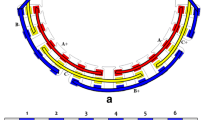Abstract
In this paper, a new optimized method for the stator design of permanent magnet synchronous machines (PSM) using parameter permutation is introduced. The proposed joint optimization of the groove form and winding design dissolves the fixed sequential steps of the conventional stator design process. This enables a holistic consideration of all possible combinations of machine parameters and aims to find the global optimum for the stator design.
Zusammenfassung
In dieser Arbeit wird ein neues optimiertes Verfahren für die Statorauslegung von permanenterregten Synchronmaschinen (PSM) unter Verwendung von Parameter Permutation vorgestellt. Die gleichzeitige Optimierung der Nutform und des Wicklungsdesigns löst die festen aufeinanderfolgenden Schritte des konventionellen Statorauslegungsprozesses auf. Dies ermöglicht eine ganzheitliche Betrachtung aller möglichen Kombinationen von Maschinenparametern und zielt darauf ab, das globale Optimum für die Statorauslegung zu finden.





Similar content being viewed by others
References
Müller G, Vogt K, Ponick B (2011) Berechnung elektrischer Maschinen, 6th edn. Wiley-VCH, Weinheim
Binder A (2012) Elektrische Maschinen und Antriebe: Grundlagen, Betriebsverhalten. Springer, Berlin
Smith A, Delgado D (2010) “Automated AC winding design”, 5th IET International Conference on Power Electronics, Machines and Drives (PEMD 2010), UK, April 2010
Steinbrink J (2008) “Design and Analysis of Windings of Electrical Machines”, International Symposium of Power Electronics, Electrical Drives, Automation and Motion (SPEEDAM), Italy 2008
Huth G (1999) Optimierung des Wicklungssystems bei permanentmagneterregten AC-Servomotoren. Electr Eng. https://doi.org/10.1007/BF01387158
Malti M, Herzog F (1940) Fractional-slot and dead-coil windings. Electr Eng 59:782–794
Meyer W (2009) Automatisierter Entwurf elektromechanischer Wandler. Hieronymus, Munich
Caruso M et al (2018) A general mathematical formulation for winding layout arrangement of electrical machines. Energies. https://doi.org/10.3390/en11020446
Tang K‑T (2007) Mathematical methods for engineers and scientists, Fourier analysis, partial differential equations and variational methods. Springer, Heidelberg, Berlin, New York
Giersch H, Harthus H, Vogelsang N (1998) Elektrische Maschinen mit Einführung in die Leistungselektronik. Springer, Wiesbaden
Heiles F (1953) Wicklungen elektrischer Maschinen und ihre Herstellung, 2nd edn. Springer, Heidelberg, Berlin, New York
Tang Y et al (2011) Investigation of winding topologies for permanent magnet in-wheel motors. COMPEL. https://doi.org/10.1108/03321641211184841
Pyrhonen J et al (2013) Design of rotating electrical machines. John Wiley & Sons Ltd, Chichester
Gerling D (2012) Frisch gewickelt. AUTOCAD & Inventor Magazin 4/12, Effizienz- und Kostenoptimierung elektrischer Antriebe
Gerling D (2011) Trends und Herausforderungen bei zukünftigen E‑Maschinen und Transformatoren. ZVEI, Fulda
Saadat H (2004) Power systems analysis, 2nd edn. McGraw-Hill, New York
Yokoi Y et al (2016) General formulation of winding factor for fractional-slot concentrated winding design. IET Electr Power Appl J. https://doi.org/10.1049/iet-epa.2015.0092
Bianchi N (2006) Use of the star of slots in designing fractional-slot single layer synchronous motors. IEE Proc Electr Power Appl. https://doi.org/10.1049/ip-epa:20050284
Tingley E (1915) Two- and three phase lap windings in unequal groups. Electr Rev West Electr 66:166–168
Wach P (1997) Multi-phase systems of fractional-slot windings of AC electrical machines. Arch Electr Eng 46:471–486
Samaha-Fahmy M (1973) Harmonic effects in rotating electical machines, Master’s thesis at the Department of Electrical Engineering, McGill University
Staton D, Goss J (2017) Open source electric motor models for commercial EV & hybrid traction motors (Motor Design Limited, CWIEME, Berlin)
Elektroauto-News.net (2018) Test- und Fahrbericht des BMW i3 – eine Woche elektrifiziert unterwegs. https://www.elektroauto-news.net/bmw-i3-test-fahrbericht-erfahrung. Accessed 8 Jan 2019
BMW Group (2016) Technische Daten BMW i3 (94Ah), gültig ab 07/2016. https://www.press.bmwgroup.com/deutschland/article/attachment/T0259598DE/359586. Accessed 4 Jan 2019
Borchardt N, Kasper R (2018) Parametric model of electric machines based on exponential Fourier approximations of magnetic air gap flux density and inductance. COMPEL 37(1):520–535
Acknowledgements
This work was supported by the organization Bayern Innovativ within the research project DeTailED—Design of Tailored Electrical Drivetrains.
Author information
Authors and Affiliations
Contributions
As first author, Svenja Kalt initiated the idea of the presented optimized stator design method, drew up the overall concept of this paper and conducted the analysis. Jonathan Erhard supported as part of his Master’s thesis with the construction of the design concept and implementation. All authors discussed and commented on the article at all stages. Markus Lienkamp made an essential contribution to the conception of the research project. He revised the paper critically for important intellectual content. Markus Lienkamp gave final approval of the version to be published and agrees to all aspects of the work. As a guarantor, he accepts responsibility for the overall integrity of the paper.
Corresponding author
Rights and permissions
About this article
Cite this article
Kalt, S., Erhard, J. & Lienkamp, M. Optimized stator design method using machine parameter permutation. Forsch Ingenieurwes 83, 853–861 (2019). https://doi.org/10.1007/s10010-019-00385-y
Received:
Accepted:
Published:
Issue Date:
DOI: https://doi.org/10.1007/s10010-019-00385-y




